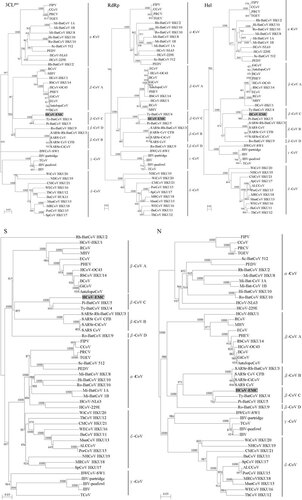Figures & data
Table 1 Characteristics of putative non-structural proteins of ORF1ab in Ty-BatCoV HUK4, Pi-BatCoV HKU5 and HCoV-EMC
Figure 1 Genome organizations of HCoV-EMC and other betaCoVs. Papain-like proteases (PL1pro, PL2pro and PLpro), chymotrypsin-like protease (3CLpro) and RNA-dependent RNA polymerase (RdRp) are represented by orange boxes. Haemagglutinin esterase (HE), spike (S), envelope (E), membrane (M) and nucleocapsid (N) are represented by green boxes. Putative accessory proteins are represented by blue boxes. HCoV-EMC is shown in bold.

Figure 2 Phylogenetic analysis of HCoV-EMC. The trees were constructed by the neighbor-joining method using Kimura correction and bootstrap values calculated from 1000 trees. 318, 951, 600, 1491 and 510 amino acid positions in chymotrypsin-like protease (3CLpro), RNA-dependent RNA polymerase (RdRp), helicase (Hel), spike (S) and nucleocapsid (N) respectively were included in the analysis. For 3CLpro, S and N, the scale bars indicate the estimated number of substitutions per 20 amino acids. For RdRp and Hel, the scale bars indicate the estimated number of substitutions per 50 amino acids. PEDV, porcine epidemic diarrhea virus (NC_003436); Sc-BatCoV-512, Scotophilus bat coronavirus 512 (NC_009657); TGEV, transmissible gastroenteritis virus (NC_002306); FIPV, feline infectious peritonitis virus (AY994055); CCoV, canine coronavirus (GQ477367); PRCV, porcine respiratory coronavirus (DQ811787); Rh-BatCoV-HKU2, Rhinolophus bat coronavirus HKU2 (EF203064); Mi-BatCoV 1A, Miniopterus bat coronavirus 1A (NC_010437); Mi-BatCoV 1B, Miniopterus bat coronavirus 1B (NC_010436); Mi-BatCoV-HKU8, Miniopterus bat coronavirus HKU8 (NC_010438); Hi-BatCoV HKU10, Hipposideros bat coronavirus HKU10 (JQ989269); Ro-BatCoV HKU10, Rousettus bat coronavirus HKU10 (JQ989270); HCoV-229E, human coronavirus 229E (NC_002645); HCoV-NL63, human coronavirus NL63 (NC_005831); HCoV OC43, human coronavirus OC43 (NC_005147); BCoV, bovine coronavirus (NC_003045); AntelopeCoV, sable antelope coronavirus (EF424621); GiCoV, giraffe coronavirus (EF424622); ECoV, equine coronavirus (NC_010327); PHEV, porcine hemagglutinating encephalomyelitis virus (NC_007732); MHV, murine hepatitis virus (NC_001846); RCoV, rat coronavirus (NC_012936); RbCoV HKU14, rabbit coronavirus HKU14 (NC_017083); HCoV-HKU1, human coronavirus HKU1 (NC_006577); Ty-BatCoV-HKU4, Tylonycteris bat coronavirus HKU4 (NC_009019); Pi-BatCoV-HKU5, Pipistrellus bat coronavirus HKU5 (NC_009020); SARS CoV, SARS-related human coronavirus (NC_004718); SARSr-Rh-BatCoV HKU3, SARS-related Rhinolophus bat coronavirus HKU3 (DQ022305); SARSr CoV CFB, SARS-related Chinese ferret badger coronavirus (AY545919); SARSr-CiCoV, SARS-related palm civet coronavirus (AY304488); Ro-BatCoV-HKU9, Rousettus bat coronavirus HKU9 (NC_009021); IBV, infectious bronchitis virus (NC_001451); IBV-partridge, partridge coronavirus (AY646283); TCoV, turkey coronavirus (NC_010800); IBV-peafowl, peafowl coronavirus (AY641576); BWCoV-SW1, beluga whale coronavirus SW1 (NC_010646); ALCCoV, Asian leopard cat coronavirus (EF584908); BuCoV HKU11, bulbul coronavirus HKU11 (FJ376619); ThCoV HKU12, thrush coronavirus HKU12 (FJ376621); MunCoV HKU13, munia coronavirus HKU13 (FJ376622); PorCoV HKU15, porcine coronavirus HKU15 (NC_016990); WECoV HKU16, white-eye coronavirus HKU16 (NC_016991); SpCoV HKU17, sparrow coronavirus HKU17 (NC_016992); MRCoV HKU18, magpie robin coronavirus HKU18 (NC_016993); NHCoV HKU19, night heron coronavirus HKU19 (NC_016994); WiCoV HKU20, wigeon coronavirus HKU20 (NC_016995); CMCoV HKU21, common moorhen coronavirus HKU21 (NC_016996).
